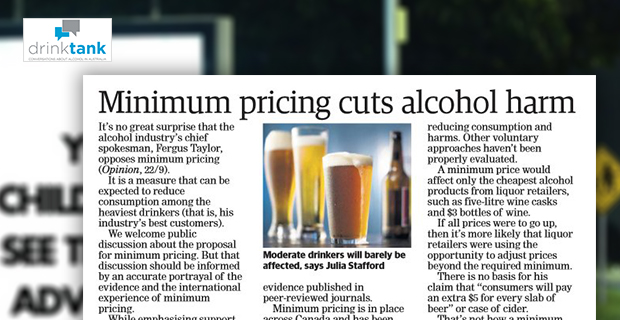Alcohol industry mouthpiece, Alcohol Beverages Australia’s Fergus Taylor played fast and loose with the truth last Friday in an opinion piece published in the West Australian that incorrectly argued that Booze floor price will hurt those doing right thing. And not for the first time; he did the same thing in the NT News not so long ago.
His op-ed was heavy on opinion, and while he is certainly entitled to one – he would do well not to confuse these with facts.
As one wag on Twitter duly noted, “I reckon this one scores a full house in ‘incorrect arguments made against minimum pricing Bingo”.
Setting the record straight in the West Australian on Monday, Julia Stafford, Executive Officer, McCusker Centre for Action on Alcohol and Youth, Curtin University, put the evidence in support of minimum unit pricing front and centre.
It’s no great surprise that the alcohol industry’s chief spokesperson opposes minimum pricing, a measure that can be expected to reduce consumption among the heaviest drinkers (his industry’s best customers). We welcome public discussion about the proposal for minimum pricing, but that discussion should be informed by an accurate portrayal of the evidence and the international experience of minimum pricing. While emphasising support for the government’s intention to address alcohol misuse and harm, Taylor attempted to dissuade the government from adopting an evidence-based measure that would reduce misuse and harm, and muddy the waters about the state of the evidence.
Taylor suggested that minimum pricing hasn’t worked in Canada on the basis that alcohol-related deaths haven’t reduced in British Columbia. This is a gross misrepresentation of the evidence published in peer-reviewed journals. Minimum pricing is in place across Canada and has been associated with significant reductions in alcohol consumption and harms, including alcohol-related hospital admissions and deaths.
Taylor’s claim that minimum pricing failed in the Northern Territory is curious given the NT doesn’t have a territory-wide minimum pricing policy (yet). However, a modest levy applied to cask wine in the 90s was successful in reducing consumption and harms. Other voluntary approaches haven’t been properly evaluated.
A minimum price would affect only the cheapest alcohol products from liquor retailers, such as five litre wine casks, $3 bottles of wine and products used as loss-leaders. If all prices were to go up, as Taylor claims, then it’s more likely that liquor retailers were using the opportunity to adjust prices beyond the required minimum. There is no basis for Taylor’s claim that “consumers will pay an extra $5 for every slab of beer” or case of cider. That’s not how a minimum price would work. Many products would already be priced above the minimum price threshold.
Minimum pricing is a targeted measure to reduce (not stop) drinking among the heaviest drinkers and would have minimal, if any, impact on moderate drinkers. It’s worthy of informed discussion.
For more information about floor price policy:
Report: The Price is Right: Setting a Floor Price on Alcohol in the Northern Territory
Media Release: Minimum unit alcohol price to deliver NT dramatic reduction in alcohol harm









Add comment